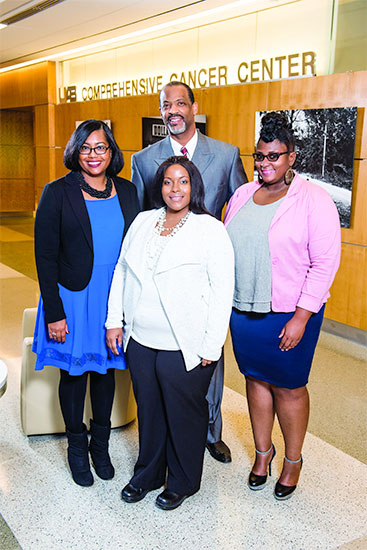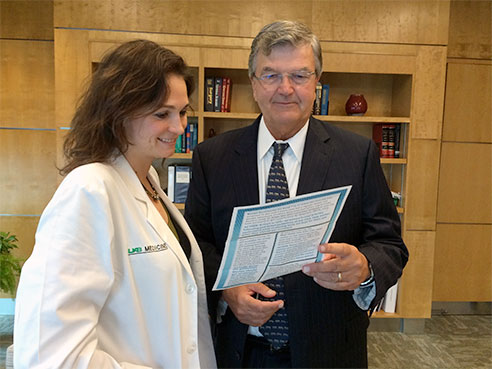 UAB's lay navigators in the Patient Care Connect Program are, from left, Myeisha Hutchinson, Ramona Colvin, Ernest Grimes, Jr. and Chinara Dosse. Photo by Nik LaymanA new University of Alabama at Birmingham study shows that, when older cancer patients were paired with trained nonmedical professionals in the form of ‘lay navigators,’ there was significant decline in health care resource utilization and Medicare costs, providing an innovative model in transitioning to value-based health care on a national scale.
UAB's lay navigators in the Patient Care Connect Program are, from left, Myeisha Hutchinson, Ramona Colvin, Ernest Grimes, Jr. and Chinara Dosse. Photo by Nik LaymanA new University of Alabama at Birmingham study shows that, when older cancer patients were paired with trained nonmedical professionals in the form of ‘lay navigators,’ there was significant decline in health care resource utilization and Medicare costs, providing an innovative model in transitioning to value-based health care on a national scale.
In cancer care delivery, costs are expected to rise to $173 billion per year by 2020, due in part to the aging population and high expenses associated with caring for geriatric patients.
The study, published today in JAMA Oncology, zeroes in on the influence of lay navigation on Medicare spending and resource use, such as emergency room visits, hospitalizations, intensive care admissions and chemotherapy in the last two weeks of life, to determine the financial implications on the health care system.
“This study provides hard-core evidence that we can reduce inefficiency and duplication of services, and at the same time make it easier for people to get the cancer care they need,” said Edward Partridge, M.D., director of the UAB Comprehensive Cancer Center and principal investigator on the study. “Unlike the traditional fee-for-service approach, where doctors and hospitals are paid based on the number of health care services they deliver, such as tests and procedures, the lay navigation program is a value-based approach that puts patients at the center, employing evidence-based medicine that takes into account each patient’s wishes and preferences.”
Over a three-year period, from 2012-2015, the observational study examined 12,428 geriatric patients, age 65 and older, enrolled in the Patient Care Connect Program through the UAB Health System Cancer Community Network, which includes 12 community cancer centers across Alabama, Georgia, Florida, Mississippi and Tennessee.
Comparisons and differences were analyzed between 6,214 navigated and 6,214 non-navigated patients. The primary exposure was contact with a patient navigator who was guided by distress screenings that assessed practical, informational, financial, familial, emotional, spiritual and physical concerns. Navigated patients were matched to non-navigated patients on age, race, sex, cancer acuity, comorbidity and pre-enrollment characteristics.
The study found total costs declined by $781.29 more per quarter per navigated patient for an estimated $19 million decline per year across the network. Inpatient and outpatient costs had the largest decline with $294 and $275, respectively, per patient per quarter. Emergency room visits, hospitalizations and intensive care unit admissions decreased per quarter by 6 percent, 7.9 percent and 10.6 percent, respectively.
“What we know for sure is that our lay navigators have a positive effect on our patients and engage them in their health care, which can be increasingly complex,” said Gabrielle Rocque, M.D., medical director of the PCCP and lead author on the study. “The extra layer of support that navigators provide can make a big difference. We have patients who tell us that they never would have made it through their treatment without their navigator.”
 Gabrielle Rocque, M.D., medical director of the Patient Care Connect Program, and Edward Partridge, M.D., director of the UAB Comprehensive Cancer Center. UAB has an established history of utilizing a variety of navigation programs and has found them to improve access to care, enhance coordination of care and overcome barriers to timely, high-quality health care. While most navigation programs focused on early detection and the initial management of care, the PCCP focuses on the whole continuum of care from diagnosis through survivorship to end of life, and in an age group with high symptom burdens, who experience more hospitalizations and incur higher medical costs.
Gabrielle Rocque, M.D., medical director of the Patient Care Connect Program, and Edward Partridge, M.D., director of the UAB Comprehensive Cancer Center. UAB has an established history of utilizing a variety of navigation programs and has found them to improve access to care, enhance coordination of care and overcome barriers to timely, high-quality health care. While most navigation programs focused on early detection and the initial management of care, the PCCP focuses on the whole continuum of care from diagnosis through survivorship to end of life, and in an age group with high symptom burdens, who experience more hospitalizations and incur higher medical costs.
“Using lay navigation is a low-cost strategy to meet the demand for navigation services,” said Rocque, assistant professor in the UAB Division of Hematology and Oncology and associate scientist at the UAB Comprehensive Cancer Center. “When done right, lay navigators can take the time-consuming pressure off the nurses and medical team through frequent telephone communication and preventive, proactive approaches that lead to earlier identification and management of symptoms.”
Despite clear benefits to patients from navigation, programs have struggled because of a lack of financial support. The PCCP helps make a financial case to organizational leadership that a navigator can manage a caseload of about 150 patients per quarter and can target high-risk, high-cost patients and patient care. Navigators are uniquely positioned to meet the needs of high-risk patients because they can engage patients in the hospital, in multiple clinics and by telephone. Navigators connect patients and their caregivers to appropriate resources across multiple disciplines, in different health care settings and within the community at large.
“Programs such as the Affordable Care Act are driving improvements in mandating better care with lower costs, and that is a good thing,” Partridge said. “And this study is a step in the right direction in that we have a definitive assessment of impact that can provide opportunities for improvement nationally and systemwide.”